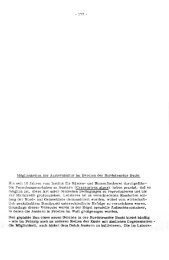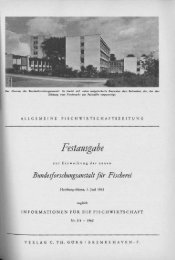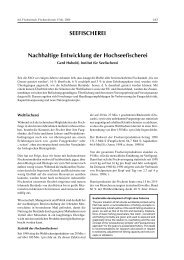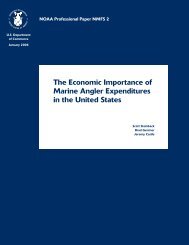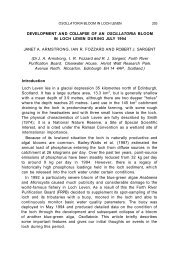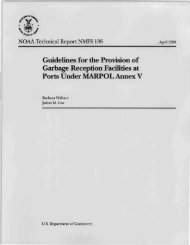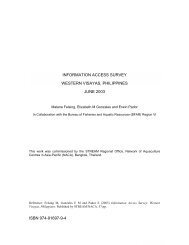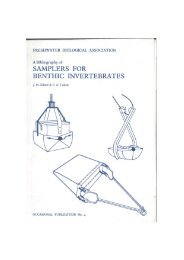Download (36Mb) - Aquatic Commons
Download (36Mb) - Aquatic Commons
Download (36Mb) - Aquatic Commons
You also want an ePaper? Increase the reach of your titles
YUMPU automatically turns print PDFs into web optimized ePapers that Google loves.
tgust 15, 1914 THE CANAL AND WORLD TRADE August 15, 1939<br />
Ships may refuel at either of the two Canal ports. This i:: a<br />
pic/me of the U. S. Army transport Mt. Vernon bunkerzng<br />
coal ai/he Cristobal coaling plant.<br />
commodities in point of tonnage. This trade<br />
showed a continuous growth until the full<br />
effects of the world-wide depression were felt in<br />
the iron and steel industry and in the year 1933<br />
shipments of ore from South America through<br />
the Canal aggregated less than 100,000 tons, as<br />
compared with more than 600,000 tons during<br />
the previous year. Heavily laden ore ships<br />
began to move through the Canal in a steady<br />
stream after the slump of 1933 and in no year<br />
since has the tonnage been less than 1,000,000.<br />
In the fi£cal year 1938 ore shipments aggregated<br />
more than 2,000,000 tons, and during the past<br />
fiscal year the total tonnage of ores was 1,991,690.<br />
Although iron ores and nitrates compose the<br />
bulk of shipments from South America through<br />
the Canal over the trade routes to the United<br />
States and to European ports, many other commodities<br />
are shipped from the west coast ports<br />
which have a great influence on the prosperity of<br />
certain areas there. Among the products<br />
shipped in large quantities every year are skins<br />
and hides, mineral oil from Ecuador and Peru<br />
to Europe, fruits, coffee, raw cotton, beans,<br />
ivory nuts and cereals.<br />
Although the greatest number of ships and<br />
the greatest amount of cargo moving through<br />
the Canal follow four principal routes, viz.,<br />
United States intercoastal; United States and<br />
West Coast of South America; Europe and the<br />
West Coast of North America; and Europe and<br />
the West Coast of South America, a considerable<br />
proportion of the traffic every year is over the<br />
routes between the United States and Hawaii,<br />
the Philippines, the Far East, and Australasia,<br />
and between Europe and Australasia.<br />
An important aspect of the commerce on these<br />
routes is that the overwhelming proportion of the<br />
cargo on the United States-Far East route is<br />
moved trom the Atlantic to the Pacific, whereas<br />
on almost all other routes the reverse is true.<br />
'During the past year approximately 90 percent<br />
of all cargo moved on this route was shipped<br />
from United States ports to the Far East. The<br />
trade balance between the United States and<br />
Australasia, as indicated in cargo tonnage over<br />
that route, is approximately twice as great from<br />
the United States to Australasia. This condition<br />
is accounted for by the fact that a large portion<br />
of the raw products of Australasia, particularly<br />
those of New Zealand, is shipped to Europe.<br />
Cargo movement between Europe and Australasia<br />
shows little fluctuation from year to year,<br />
approximately 1,000,000 tons having been moved<br />
annually over this route during the past 20 years.<br />
The amount of cargo shipped from Australasia<br />
to Europe is much greater than from Europe<br />
to Australasia. The p:-incipal commodities<br />
moved over this route are refrigerated meats,<br />
dairy products, wool, sugar, skins and hides<br />
If,ere are wide Ructualions from year to year in the number of ships of the various nationalities and the amount of cargo carried<br />
by the ships of each nation. The following table shows the amount of cargo carried by ships of ten leading maritime nations<br />
during each of the past five fiscal years and the percentage of total cargo carried by ships of each nationality in the fiveyear<br />
period·<br />
Nationality<br />
1935 1936 1937 1933 1939<br />
Pcrcent-<br />
I I I I I<br />
age<br />
United Statcs_________________________ 10,825,573 10,700,535 9,844,254 9,892,619<br />
British_______________________________<br />
9,909,380 37.9<br />
5,776,021 6,181,571 7,179,136 6,417,016 6,801,556 23.9<br />
2,463,675 2,717,860 3,506,109 3,433,571 3,408,078 11.5<br />
k~~~~~~~~~==========================<br />
crman ______________________________<br />
1,446,049 1,697,880 1,789,178 1,877,502 1,710,303 6.3<br />
1,300,991 1,305,090 1,496,084 1,518,593 1,468,99G 5.2<br />
wed ish 782,548 855,409 775,800 763,049 1,008,245 3.1<br />
Danish _-_- ~ =========================== 555,981 627,407 757,379 865,235 727,552 2.6<br />
. etherlands 439,168 511,620 700,725 749,642 675,105 2.3<br />
~rcnch __ : __ ========================== 570,034 544,343 542,539 567,288 501,752 2.0<br />
anamanlan 121,758 654,610 627,812 415,561 371,721 1.6<br />
All others __ ~= ======================== 1,027,729 709,618 889,369 885,848 1,283,939 3.6<br />
TotaL___________________________<br />
25,309,527 26,505,943 28,108,375 27,385,924 27,866,627 100.0<br />
Page seventy-thre~




